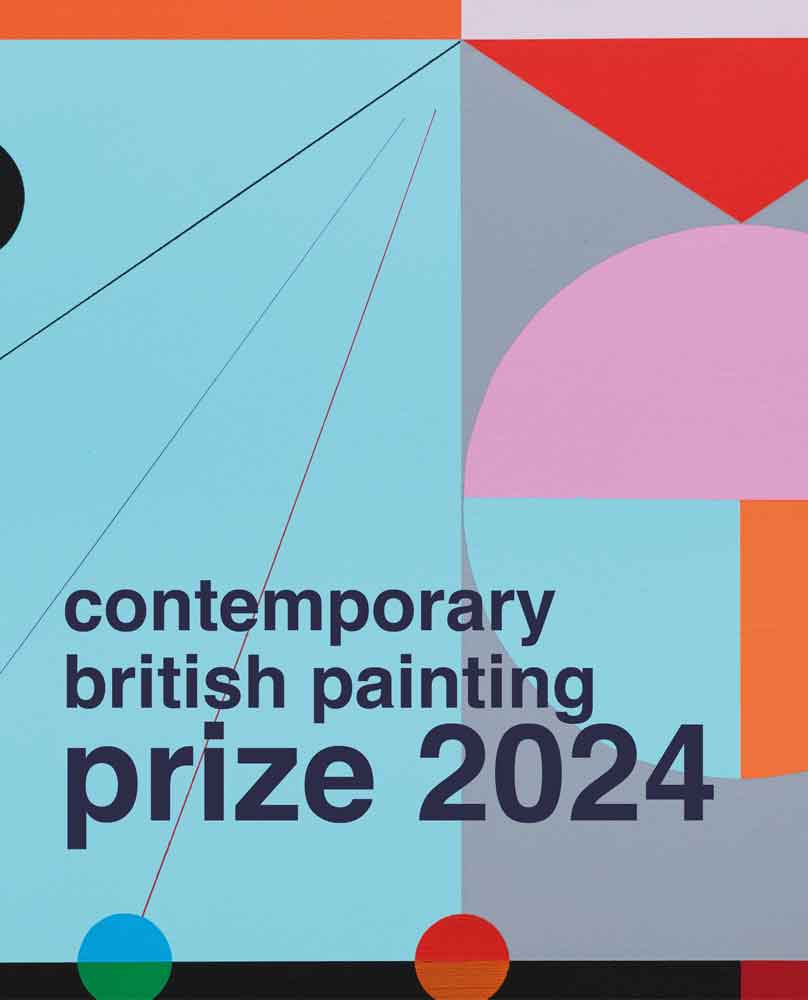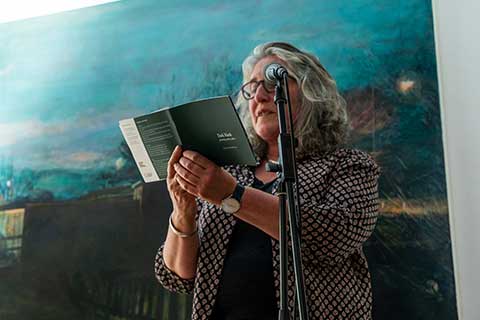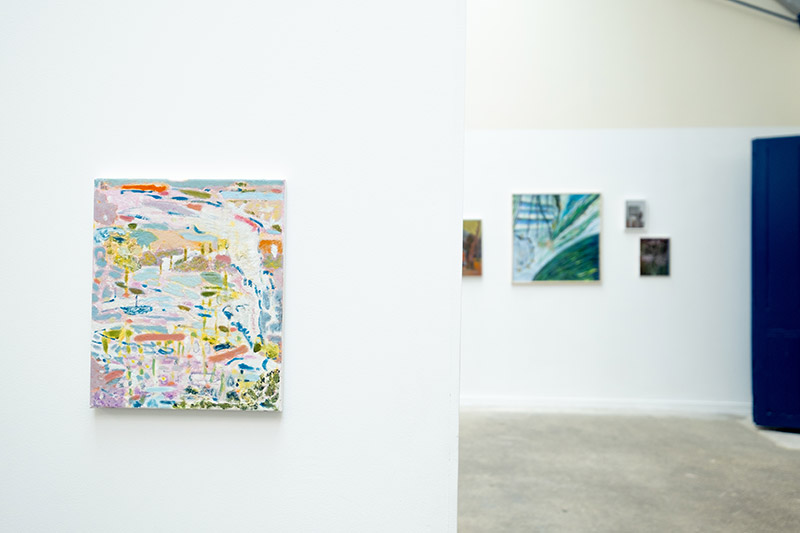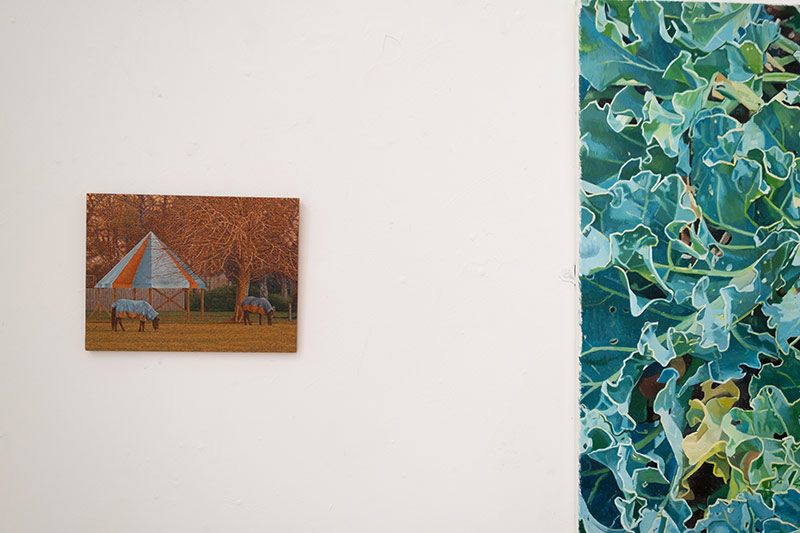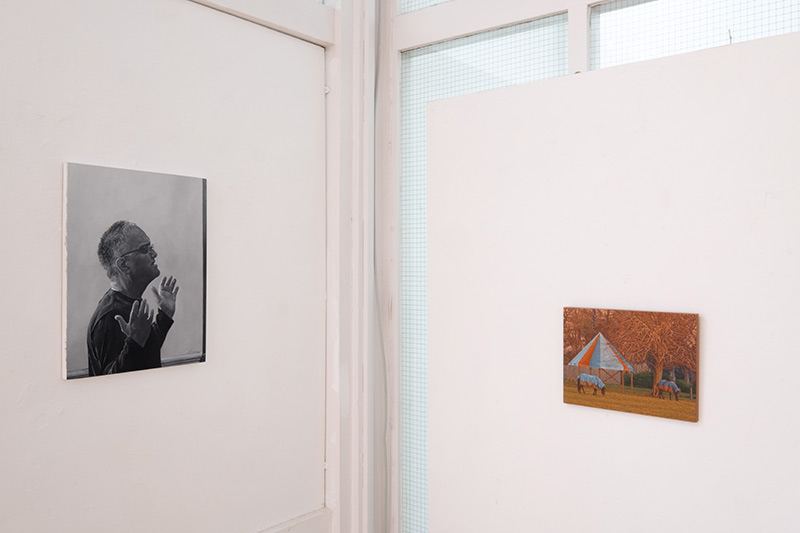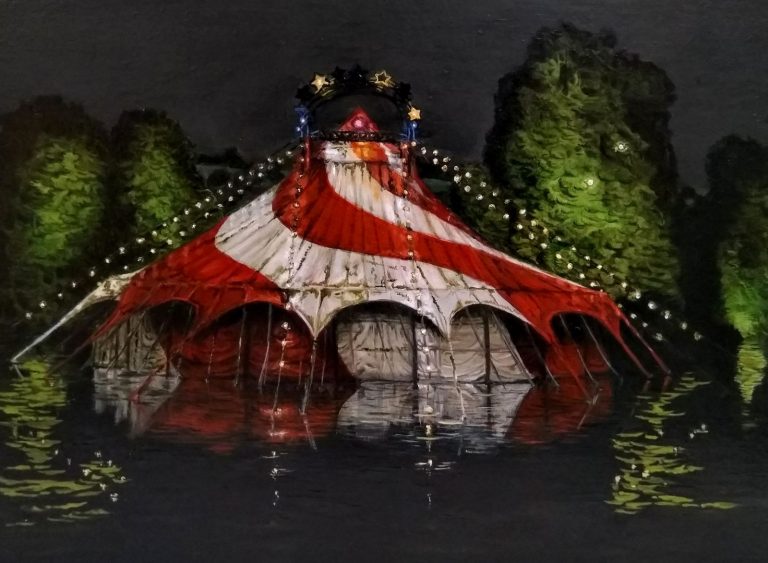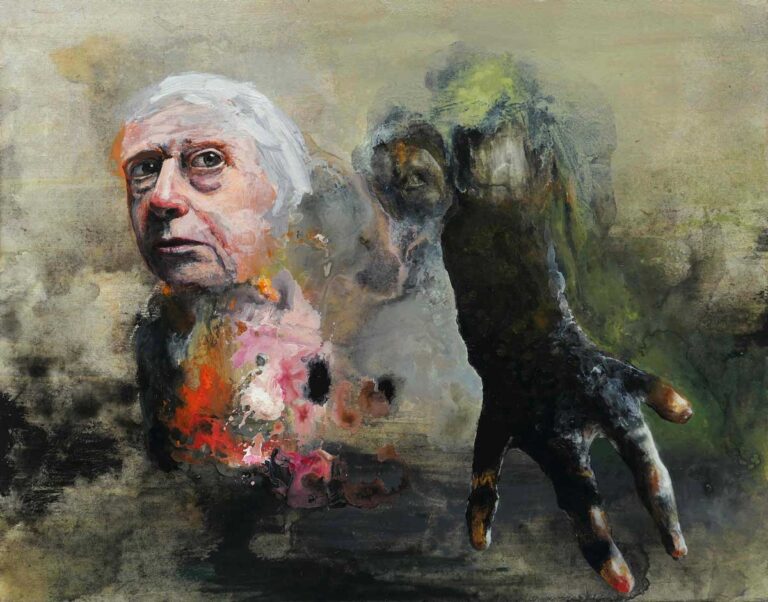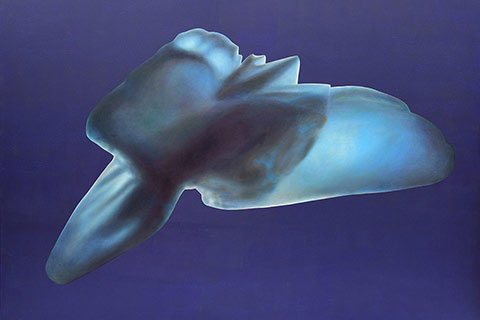Slow Painting
Cultural Landscapes at Studio KIND
Slow painting
The summer of 2024 saw SLOW PAINTING, a dual-sited exhibition hosted by The Plough Arts Centre and Studio KIND featuring works by Contemporary British Painting members and guests. Peter Stiles writes about how the exhibition was first discussed between him and former Contemporary British Painting chair Judith Tucker, and how it subsequently developed and came into being.



Exhibitions sometimes take a complicated route in order to come to fruition. The exhibition Slow Painting – featuring members of Contemporary British Painting alongside some guest regional artists and spans two venues some 14 miles apart – more than most.
I’m a painter and co-director of Studio KIND. and until recently gallery director of The Plough Arts Centre. In 2019 I’d shown Judith Tucker’s work alongside the poetry of her partner, Harriet Tarlo, as part of an exhibition curated by Camilla Nelson entitled Radical Landscapes: Innovation in Landscape and Language.
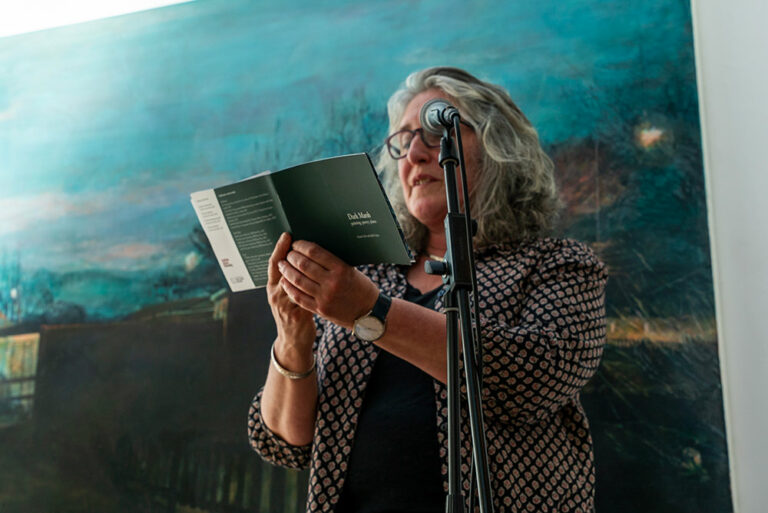
Photo credit Phil Saunders Beep Media.
In September 2017, Judith Tucker had curated In The Open, a large exhibition of contemporary innovative language and landscape work for the biennial ASLE-UKI conference in Sheffield. Radical Landscapes built on that show in order to explore the continuum between drawn, painted, written, collaged and projected marks in the construction of landscape.
The painting that Judith showed at The Plough was an early example of ‘The Fitties’ series and went on to win the Jacksons Art Prize. The Fitties are a colony of about 300 chalets, huts, and cabins on former salt marshes on the Lincolnshire coast that formed a focus for Judith and Harriet’s work over an extended period.

There were a number of walks and events running alongside The Plough show including a poetry reading and a foraging walk. Harriet and Judith enjoyed walking around in the sunshine occasionally munching on the grasses and leaves that our guide suggested, and in a rather vague way we agreed that it would be great if they could come back, exhibit and walk again. COVID-19 interrupted everyones plans for a while but I bumped into Judith at a number of events, and when she became the Chair of CBP the idea for a show crystallised around her suggestion that we took Judith Westgeest’s book Slow Painting as the starting point for a show.
Judith thought that most painters had an angle on what the concept of ‘slow painting’ might mean in relation to their own practice. It was a stimulating theme but broad enough not to become prescriptive. It was a generous theme – which was a word Judith valued highly and used a lot.
One of the extracts from Westgeest’s book that she suggested contributors read was this:
“The fleeting nature of digital mass media appears to have unlocked a desire for more physically stable and enduring pictures, like paintings. Slow Painting charts how, in a world where the constant quest for speed can leave us exhausted, the appeal of this ‘slower medium’ has only grown …
Our culture today is marked by the ever-growing presence of images, and because their rate of circulation also keeps going up, we are increasingly discouraged from engaging in critical reflection on the individual image. By contrast, the world of painting represents a long tradition of works of art that stimulate contemplation on strategies in visual communication …..
Although quite a few art critics expected painting to disappear in the digital age—much in the same way as anticipated after the invention of photography—current developments in photography, video, and new media art indicate a revived interest in visual strategies developed in painting. Moreover, the fleeting images of digital mass media seem to have fostered a longing for physical and more stable pictures, such as paintings. And for the last several years, during which “ever faster” became harder to attain, we have been witnessing a growing interest in “slowness” of different kinds (e.g., slow food), as well as a desire for more reflection on all sorts of stimuli in our increasingly digital daily environment.”

This theme meant that it was likely that we would draw in a wide variety of work ranging from those who thought that painting per se had the quality of slowness, to painting that took a long time to complete and painting that, through a variety of strategies, slowed its audience down.
We booked a date and I contacted Studio KIND. which was a relatively new artist-led venture, run by artist Laura Porter who had recently completed an MA at Camberwell. She was writing another bid to Arts Council with the prospect of being invited into a new space within the newly refurbished Pannier Market in Barnstaple. She was enthusiastic about the idea of a collaboration and the opportunity to bring so many contemporary painters to the area, especially with her keen interest in ensuring North Devon isn’t excluded from broader visual arts discourse.

After the sad and terrible news about Judith’s death in a traffic collision in November 2023, there was a space of time before I was contacted by Paula MacArthur from CBP about the show. She pulled the loose threads together and we decided that the show could go ahead and include a dedicated section in memory of Judith.

I think, for Judith, the concentration on a theme, the most recent being the Fitties which, in its latest iteration ‘Hideaway,’ was conducted alongside the Dark Marsh series responding to the adjacent salt marsh – inevitably slowed down the process of painting pictures in a way that suited her. It drew in other collaborators (apart from her ongoing partnership with Harriet), such as the inhabitants of the Fitties with their stories and then environmental expertise and the broader context of climate and social change; expanding from the particularities of place into the global. Her paintings too, the way that the rectangles of light shining at the windows appear suspended within the picture, give the spectator a moment of stillness and identification that leans towards a suspension not only within space but also within time. And when we get to the salt marsh series the matted tangled web of plants catches the eye within the network that she creates and prevents the eye from escaping. Given the role of the plants in preventing coastal erosion by reducing the energy of the water as it flows through and around them, this entanglement of consciousness becomes a political metaphor. Slowing things down, not only externally but also internally – as a way of addressing climate change
I remember talking to the abstract painter Henry Mundy about the juxtaposition of flat and patterned areas of colour; how the patterned areas slowed down the eye in comparison with the broader shapes of pure colour, which could be taken in almost instantaneously. Oddly enough, the way in which Judith juxtaposed areas of space with areas of detail reminded me of this kind of thinking.
Another painting in the show by Stuart Edmundson has a similar dynamic. Fast shapes and lines slowed down by twists in the structure and dots. Henry Mundy, like many abstract painters of his generation, was painting in response to the American legacy of colour field painters. When Kenneth Noland stated that he was aiming for ‘one shot’ paintings he was talking about a speed of production as well as the distaste for revision. And the normal process by which the spectator is coerced into putting together the separate parts of the painting to construct a unified whole was attacked via paintings such as the target series where Noland wanted the whole painting to be apprehended instantaneously.

In one of the paintings on show, ‘Frankfurter’ by Geraint Evans, which depicts an American fast food van in front of an American wilderness, this love of speed is referenced but set against the older tradition of American sublime. The comedy created by the giant phallic model frankfurters is complex. In the context of a show about slow painting the juxtaposition of the man-made and the natural feels less like a joke and more like an invitation to collude in the artifice of the painting – collaborate in a slow build-up of layers of meaning; sexual, historical and environmental.
I would be surprised if much of the work on show has been directly created in response to the theme but I would guess that most found it easy enough to select existing work that was relevant. Paula MacArthur’s careful depictions of crystals suspended in space feel as if they have grown as slowly as the crystals themselves. It’s hung by a picture of a fence by Narbi Price, and a diptych of a tortoise by Ruth Murray – all three paintings done with the kind of care and use of repetitive pattern that invite contemplation.

Other paintings are slow in the sense that they have been built over a long period of time. Bill Stewart has been drawing on experiences hitchhiking in America for many years – digging deeper into the memories which, by now, are layered with painted imagery and change with each fresh iteration. They may look as if they are painted very quickly but the foundations on which they are built are deep.
One of the most enjoyable aspects of the show was the day when participating artists spoke briefly about their work at The Plough. I know that in general, opportunities for painters to come together to talk about their work are rare but in rural North Devon especially so! And looking at the work of a cross section of contemporary painters usually involves travelling to a city. With a bit of luck, Studio KIND. can play a part in establishing a permanent contemporary art space in Barnstaple where such gatherings can take place more often.

Photo credit Phil Saunders Beep Media.
For my part, my painting in the show is of a rock, begun over 35 years ago when I took time out from The Slade to come down to North Devon for a few months in the winter of ‘79. As I painted my rock I remember thinking that in another couple of years I would be really good painter. At the end of a productive day I can see that good painting in the distance and it doesn’t look very far away – just a couple more years of slow painting. I’m bound to reach it at some point, aren’t I?
Peter Stiles

Photo credit Phil Saunders Beep Media.
CBP artists: Susan Absolon, David Ainley, Iain Andrews, Amanda Ansell, Karl Bielik, Claudia Bose, Day Bowman, Marius von Brasch, Lesley Bunch, Robbie Bushe, Ruth Calland, Simon Carter, Jules Clarke, Graham Crowley, Gordon Dalton, Lisa Denyer, Sam Douglas, Natalie Dowse, Nathan Eastwood, Geraint Evans, Susan Gunn, Kirsty Harris, Roland Hicks, Marguerite Horner, Barbara Howey, Phil Illingworth, Bryan Lavelle, Andrew Litten, Paula MacArthur, David Manley, Enzo Marra, Gavin Maughfling, Ruth Murray, Stephen Palmer, Mandy Payne, Ruth Philo, Katie Pratt, Narbi Price, Freya Purdue, Katherine Russell, Harvey Taylor, Sally Taylor, Molly Thomson, Ehryn Torrell, Judith Tucker, Joanna Whittle, Sean Williams.
Guest Artists: Llyr Davies, James Dearlove, Stuart Edmundson, Petra Freeman, StevieRay Latham, Janet Sainsbury, Bill Stewart, Peter Stiles and Kieran Walsh.
Carousel images courtesy of Studio KIND.


